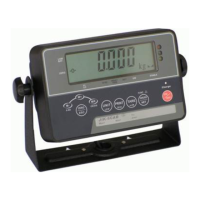Service Manual Indicator JIK-6 Page 22
5-3 L/C-related Technology
LOAD CELL Defect Judgment:
1. Static Measurement: Measure the numerical values of resistance of L/C E+ to S+ and S- (or E- to
S+ and S-) by use of an avometer at ohm step to see of they is the same. Generally speaking, if the
error is over 0.5Ω, offset is required; if the error is too big (over 2Ω), it is recommended to replace
L/C.
2. Dynamic Measurement: Correctly connect L/C with main board, measure the voltage of S+ to
ground and that of S- to ground by use of a digital ammeter at DCV step (better over 4.5 digits) to
see if they are equal (better with 0 error); if not equal, L/C offset is required.
Scale Grinding: (Please refer to Fig. I)
1. First perform weight calibration.
2. Measure the four “four-corner testing points” of the weighing pan under 1/3 of full load weight, and
check the show value.
3. Use a file to grind the L/C “Scale Grinding Point” corresponding to the min. weighing capacity point
of the four corners 1-4 (when grinding for the first time, please test force by means of trial grinding
with small strength so as to avoid damage to L/C); after grinding, press ZERO key to measure the four
corners again.
4. Repeat steps 2~3 until the error of the four corners of the weighing pan with the center as the
benchmark is within ±1 bounce, then recalibrate weight.
5. If it is still oversize after scale grinding, it means malfunction of the L/C.
6. Pay attentions to L/C specification when grinding; the lighter full load weight, the weaker grinding
force.
Weighing
pan
Fixing position
of weighing pan
or bracket
Number
corresponding to
the weighing pan
(Fig. I)
L/C fixing
position
Scale Grinding
Point

